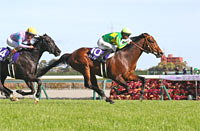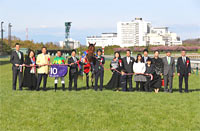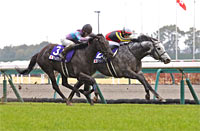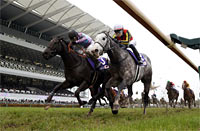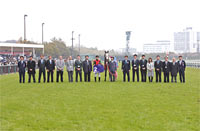Takamatsunomiya Kinen (G1) - Data Analysis
Spring sprint championship often distinguished by new winners
In the last two years, the Takamatsunomiya Kinen was won by horses that had never won a graded race before (Big Arthur in 2016, Seiun Kosei in 2017). Moreover, 2015 winner Aerovelocity was trained in Hong Kong and had never participated in a JRA race before, while 2014 winner Copano Richard had never appeared in a 1,200 meter race before. Our attention in this race should naturally also focus on horses with a favorable track record in sprint races and those aiming for the title of new champion. This time, let’s analyze some features shared by successful runners in this race based on results over the last 10 years.
Watch performance from October of the previous year
Of the 29 Top 3 finishers (after excluding foreign-trained horses) in the last 10 years, 28 (2008 runner-up Kinshasa no Kiseki being the exception) achieved Top 2 finishes in “JRA graded races held from October of the previous year”. Moreover, 2015 winner Aerovelocity (trained in Hong Kong) secured a victory in the Hong Kong Sprint (G1) held in December of the previous year. Horses that have not achieved a Top 2 finish for a while, and horses that have mainly appeared in allowance races or open-class but not graded races need to be discounted. [Table 1]
[Table 1] Japanese-trained horses’ performance by experience of finishing in Top 2 in JRA graded races held from October of previous year (last 10 years)
| Top 2 experience |
Performance
[1st-2nd-3rd-4th or lower] |
Win ratio |
Top 2 ratio |
Top 3 ratio |
| Yes |
9-9-10-58 |
10.5% |
20.9% |
32.6% |
| No |
0-1-0-89 |
0% |
1.1% |
1.1% |
Finish in previous outing and career starts are key points
Looking at performances over the last 10 years in terms of finish in the previous race, we note that horses with a “Top 2” finish last time out achieved a Top 3 ratio of 37.5%, a strong outcome. Conversely, Top 3 ratios were only 15.0% for horses that finished “3rd to 5th” in their previous race, and 3.7% for horses that finished “6th or lower”. In other words, horses that emerged as strong performers in their previous outing tend to do well in this race. [Table 2]
[Table 2] Performance by finish in previous outing (last 10 years)
Finish in
previous outing |
Performance
[1st-2nd-3rd-4th or lower] |
Win ratio |
Top 2 ratio |
Top 3 ratio |
| Top 2 |
8-7-6-35 |
14.3% |
26.8% |
37.5% |
| 3rd to 5th |
2-2-2-34 |
5.0% |
10.0% |
15.0% |
| 6th or lower |
0-1-2-78 |
0% |
1.2% |
3.7% |
In addition, of the horses that finished 3rd or lower in their previous outing, those with “20 career starts or above” delivered a poor Top 3 ratio of 2.6%. Accordingly, we should not expect too much of horses that finished outside of the Top 2 in their previous outing and have racked up 20 career starts or more. [Table 3]
[Table 3] Performance by career starts for horses that finished 3rd or lower in previous outing (last 10 years)
| Career starts |
Performance
[1st-2nd-3rd-4th or lower] |
Win ratio |
Top 2 ratio |
Top 3 ratio |
| 19 or below |
2-1-4-38 |
4.4% |
6.7% |
15.6% |
| 20 or above |
0-2-0-74 |
0% |
2.6% |
2.6% |
Look for horses that were favorites in previous outing
Of the 30 Top 3 finishers in the last 10 years, 25 had their last outing in a “Japanese race” in which they were among the “Top 4 favorites”. Meanwhile, horses backed as “5th favorite or lower” in their previous outing produced zero winners, and their Top 3 ratio was only 3.2%. A comparison of the outcomes of the previous race suggests we need to focus not only on the finish position but also on favoritism. [Table 4]
[Table 4] Performance by favoritism for horses with last outing in Japanese race (last 10 years)
Favoritism
in last outing |
Performance
[1st-2nd-3rd-4th or lower] |
Win ratio |
Top 2 ratio |
Top 3 ratio |
| Top 4 favorites |
9-9-7-54 |
11.4% |
22.8% |
31.6% |
| 5th favorite or lower |
0-1-2-90 |
0% |
1.1% |
3.2% |
Poor performance by lighter horses
Of the 20 Top 2 finishers in the last 10 years, 19 (2009 winner Laurel Guerreiro being the exception) weighed out at “480kg or above” last time out. Conversely, horses of “less than 480kg” only achieved a Top 3 ratio of 10.2%, with performance after 2010 deteriorating further to [0-0-3-36] (Top 3 ratio of 7.7%). Accordingly, we should not expect too much from lighter horses in this race. [Table 5]
[Table 5] Performance in terms of body weight in previous outing (last 10 years)
Weight in
previous outing |
Performance
[1st-2nd-3rd-4th or lower] |
Win ratio |
Top 2 ratio |
Top 3 ratio |
| Less than 480kg |
1-0-4-44 |
2.0% |
2.0% |
10.2% |
| 480kg or above |
9-10-6-103 |
7.0% |
14.8% |
19.5% |
Note: Body weight for horses that contested their last race in Hong Kong was calculated using a conversion of 1 pound to 0.453kg (rounded down; refer to International Agreement on Breeding, Racing and Wagering)
Runners occupying the inner brackets have dominated in recent years
Of the 12 Top 3 finishers in the last four years, nine entered the race with the numbers “1-9.” Meanwhile, horses with numbers “10-18” produced zero winners and had a Top 3 ratio of only 8.3%. Horses with numbers “10-18” performed well prior to 2013, but if trends in recent years are anything to go by, runners starting in inner brackets should be rated highly. [Table 6]
[Table 6] Performance by horse number (last four years)
| Horse number |
Performance
[1st-2nd-3rd-4th or lower] |
Win ratio |
Top 2 ratio |
Top 3 ratio |
| 1st |
0-0-0-4 |
0% |
0% |
0% |
| 2nd |
0-0-0-4 |
0% |
0% |
0% |
| 3rd |
0-1-0-3 |
0% |
25.0% |
25.0% |
| 4rd |
2-0-0-2 |
50.0% |
50.0% |
50.0% |
| 5th |
1-0-0-3 |
25.0% |
25.0% |
25.0% |
| 6th |
1-1-0-2 |
25.0% |
50.0% |
50.0% |
| 7th |
0-0-1-3 |
0% |
0% |
25.0% |
| 8th |
0-0-1-3 |
0% |
0% |
25.0% |
| 9th |
0-0-1-3 |
0% |
0% |
25.0% |
| 10th |
0-0-0-4 |
0% |
0% |
0% |
| 11th |
0-0-0-4 |
0% |
0% |
0% |
| 12th |
0-0-0-4 |
0% |
0% |
0% |
| 13th |
0-0-0-4 |
0% |
0% |
0% |
| 14th |
0-0-0-4 |
0% |
0% |
0% |
| 15th |
0-1-0-3 |
0% |
25.0% |
25.0% |
| 16th |
0-0-1-3 |
0% |
0% |
25.0% |
| 17th |
0-1-0-3 |
0% |
25.0% |
25.0% |
| 18th |
0-0-0-4 |
0% |
0% |
0% |
| 1st–9th |
4-2-3-27 |
11.1% |
16.7% |
25.0% |
| 10th–18th |
0-2-1-33 |
0% |
5.6% |
8.3% |
Seek out the winner!
Prudent to focus on horses with shorter careers
The four winners in the past four years all had 16 or fewer career starts. Incidentally, 2013 winner Lord Kanaloa and 2012 winner Curren Chan both achieved a win in their 14th race. Accordingly, we should not expect too much from horses with longer careers. In addition, the last four winners all have the following three points in common: (1) they contested the race with numbers 1–9, (2) they came in 5th or higher in their previous outing, and (3) they weighed out at “480kg or above” in their previous outing. Accordingly, when considering this trend, we should also take into account various other trends, including those in [Table 2], [Table 5], and [Table 6]. [Table 7]
[Table 7] Winners’ career starts, finish in previous outing, body weight in previous outing, and horse number (last four years)
| Year |
Winner |
Career starts |
Horse number |
Finish in
previous outing |
Weight in previous outing |
| 2014 |
Copano Richard |
11 |
5 |
1st |
488kg |
| 2015 |
Aerovelocity |
16 |
4 |
2nd |
539kg |
| 2016 |
Big Arthur |
10 |
4 |
5th |
524kg |
| 2017 |
Seiun Kosei |
14 |
6 |
2nd |
500kg |
Note: Body weight for horses that contested their last race in Hong Kong was calculated using a conversion of 1 pound to 0.453kg (rounded down; refer to International Agreement on Breeding, Racing and Wagering)
(Masaya Ibuki)
|















